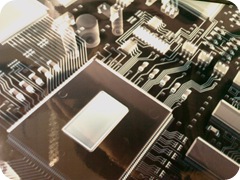 Since my husband* and I both work in IT (ie. we are both geeks), our home network is rather expansive. And by home network, I am talking about the computer kind.
Since my husband* and I both work in IT (ie. we are both geeks), our home network is rather expansive. And by home network, I am talking about the computer kind.
We have always run a Windows Active Directory (and before that, and NT4 domain), with a variety of services built onto it, like Exchange, ISA, etc.
Our newest field of exploration is virtualisation in the shape of Hyper-V, built onto a Windows 2008 platform. This means that, finally, we are using our 64-bit AMD machines to their full potential – they were previously used as desktops.
So, what is 64-bit and how is it different from ‘normal computers’?
Bit processing refers to the processor’s ability to store information about the stuff it is working on, in a nutshell. In 64 bit processing, the processor can store more information, and thus process more than in a 32 bit processor, making it considerably faster. It also means it can use more memory in the computer.
And 64 bit processing has been available in the server market for years and years (since the 1960s, in fact), but has only really become accessible to the home user in 2003.
One snag is, however, that while you can load your normal 32 bit operating system on a 64 bit machine, you are not going to be able to use the full potential of the beast. So, for a true performance shift, you will need to change your operating system. Luckily, there are 64 bit versions available for Windows XP and Windows Vista.
Another thing to keep in mind is that, should you go 64 bit with your Operating System, you will also need to install the 64 bit versions of all the updates, rather than the 32 bit. This is particularly important with the .Net framework and similar.
* the husband has only recently made his move to IT, after watching for years how much fun I was having.

No comments:
Post a Comment